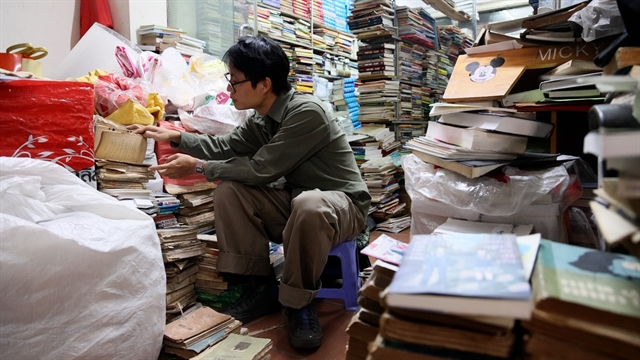 Life & Style
Life & Style


|
| Bookstores line the street in the Jimbocho area in Chiyoda Ward, Tokyo.THE JAPAN NEWS/ANN Photo |
TOKYO – About a kilometre north of the Imperial Palace lies a district called Jimbocho, home to what is said to be one of the world’s largest concentrations of used bookstores. More than 100 bookstores, many of them specialising in various genres, are crowded together along bustling Yasukuni-dori avenue in Chiyoda Ward, Tokyo.
From October to December, three experts will take turns giving seminars under the theme of What Kind of Town is Jimbocho? A Story of Antiquarian Books and Publishing at Kudan-Kaikan Terrace in the ward, explaining the town’s history as well as the publishing and bookstore industries.
Susan Taylor, who has a PhD in anthropology from Harvard University, will deliver the first lecture in the series from 6.30pm. on October 10, speaking about why so many bookstores in Jimbocho have remained in business for over 100 years.
“The textual history of Japan can be seen in Jimbocho, and objects that show the textual history of much of the rest of the world too,” Taylor, who has conducted ethnographic fieldwork in Jimbocho, told The Japan News in an email interview.
Taylor, from Tennessee, first encountered the book town while she was studying abroad in Tokyo when a classmate’s friend showed her around. Later she visited Jimbocho again to buy books to take back home.
“I remember getting lost among the bookshelves, and I was captivated by this maze that blended city space with the space of books,” she recalled.
Many bookstores have materials that play a major role in the course of history, she argues, but the world today has largely given up on the culture of bookstores and printed books resulting in book towns like Jimbocho disappearing from big cities. Amid such circumstance, she found it interesting to explore the social factors that have made Jimbocho endure.
Taylor will also give a presentation on November 28 about how old book exchange events help us understand the marketplace.
On October 26 and December 19, Masaki Kobayashi, editor-in-chief of Modern Publishing Studies, will explore the history of how Jimbocho transformed into a bookstore district through maps and photographs.
On November 15 and December 14, Gunma Women’s University Associate Prof. Chikahiko Suzuki will talk about the mechanisms and history of the publishing industry from the perspective of Jimbocho.
The seminars are all free, but registration is required at “jimbocho-publishing-seminar.peatix.com” .
All the seminars are available in several languages supported by Toppan Inc.’s multilingual automatic translation technology.
Separately, nighttime walking tours titled Night Walk in Jimbocho: Books, Bites, and Multi-Language Fun will be organised on November 16 and 21 and December 5 from 6pm starting from Shogakukan Building in the ward.
Participants visit bookstores and stroll through the alleys lined with eateries and restaurants with a guide to learn about the district, which is also a popular destination for gourmet food. The event is free. For more details, visit the English website “Night Walk in Jimbocho: Books, Bites, and Multi-Language Fun”. — The Japan News/ANN